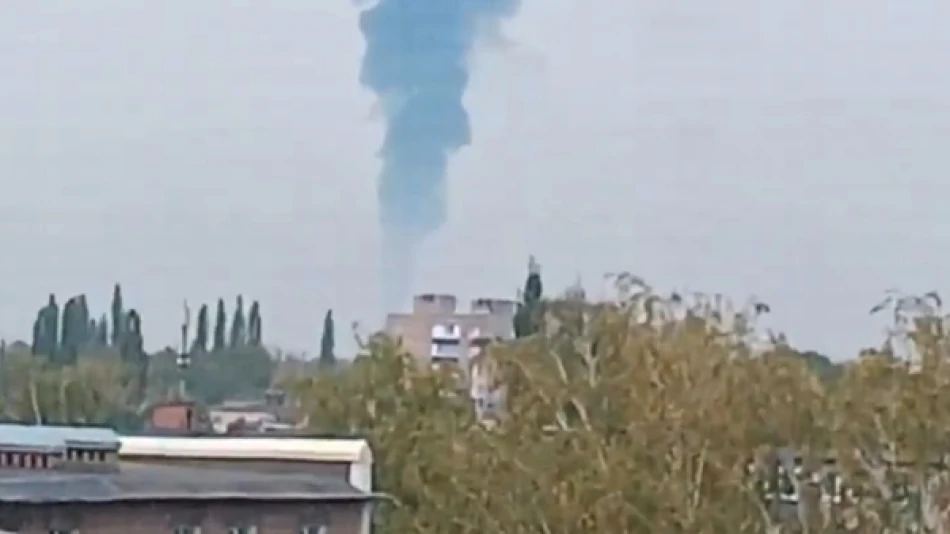
Ukrainian Forces Strike Russian Oil Facility in Daring Raid
Ukraine Strikes Deep: Drone Attack on Russian Oil Refinery Signals Major Escalation in War Strategy
Ukrainian forces have demonstrated their expanding long-range capabilities by successfully targeting a major Russian oil refinery nearly 1,400 kilometers from the front lines, marking a significant escalation in Kyiv's strategy to strike critical energy infrastructure deep within Russian territory. The Thursday attack on Gazprom's facility in Bashkortostan represents Ukraine's boldest attempt yet to disrupt Russia's energy sector, which remains the backbone of its war financing.
Strategic Depth: Ukraine's Growing Reach Into Russian Territory
The Ukrainian Security Service confirmed that its drones struck the "heart" of the Gazprom-owned refinery in Bashkortostan, a region that until recently seemed beyond Ukraine's military reach. Social media footage showed thick black smoke billowing from the industrial site, while regional governor Radi Khabirov acknowledged that two Ukrainian drones had caused a fire at the facility.
This attack follows a pattern of increasingly sophisticated Ukrainian operations targeting Russian energy infrastructure. Just last Saturday, another Ukrainian drone crashed at one of the region's largest oil refining complexes, suggesting sustained pressure on Russia's energy sector.
Economic Warfare Through Energy Targeting
The choice to target Gazprom facilities represents more than military strategy—it's economic warfare. Russia's state energy giant has been a primary funding source for Moscow's military operations, generating billions in revenue despite international sanctions. By striking refineries rather than just military targets, Ukraine aims to disrupt both fuel supplies for Russian forces and revenue streams for the war effort.
Technical Achievement: Long-Range Drone Capabilities
The 1,400-kilometer range demonstrated in this attack showcases Ukraine's rapid advancement in drone technology and operational planning. This distance rivals capabilities typically associated with cruise missiles, suggesting either significant improvements in Ukrainian-developed systems or successful adaptation of existing technology.
The precision required to hit specific industrial targets at such distances indicates sophisticated navigation and targeting systems, potentially supported by real-time intelligence gathering. This technical leap puts virtually all Russian energy infrastructure within potential striking distance.
Regional Impact and Russia's Vulnerability
Bashkortostan's location in Russia's Urals region makes it a critical hub for oil processing and distribution. The repeated targeting of facilities in this area exposes the vulnerability of Russia's energy infrastructure, which was designed during an era when such long-range attacks seemed impossible.
Governor Khabirov's confirmation that no casualties occurred suggests Ukrainian forces may be deliberately avoiding civilian targets while focusing on industrial infrastructure—a strategy that maximizes economic impact while limiting international criticism.
Implications for the Broader Conflict
These deep-strike capabilities fundamentally alter the conflict's dynamics. Russia can no longer assume its energy infrastructure is safe from Ukrainian retaliation, potentially forcing Moscow to divert air defense resources from the front lines to protect industrial sites across its vast territory.
For international energy markets, the attacks demonstrate that Russian energy exports—already constrained by sanctions—face additional disruption from military action. This uncertainty could maintain upward pressure on global energy prices and accelerate Europe's efforts to diversify away from Russian energy sources.
The successful strikes also signal to international partners that Ukraine's military capabilities continue evolving, potentially influencing future weapons deliveries and strategic support. As Ukraine proves it can project force deep into Russian territory, the conflict's geographic scope expands far beyond the traditional front lines, reshaping the strategic calculus for both sides.
Most Viewed News

 Layla Al Mansoori
Layla Al Mansoori






